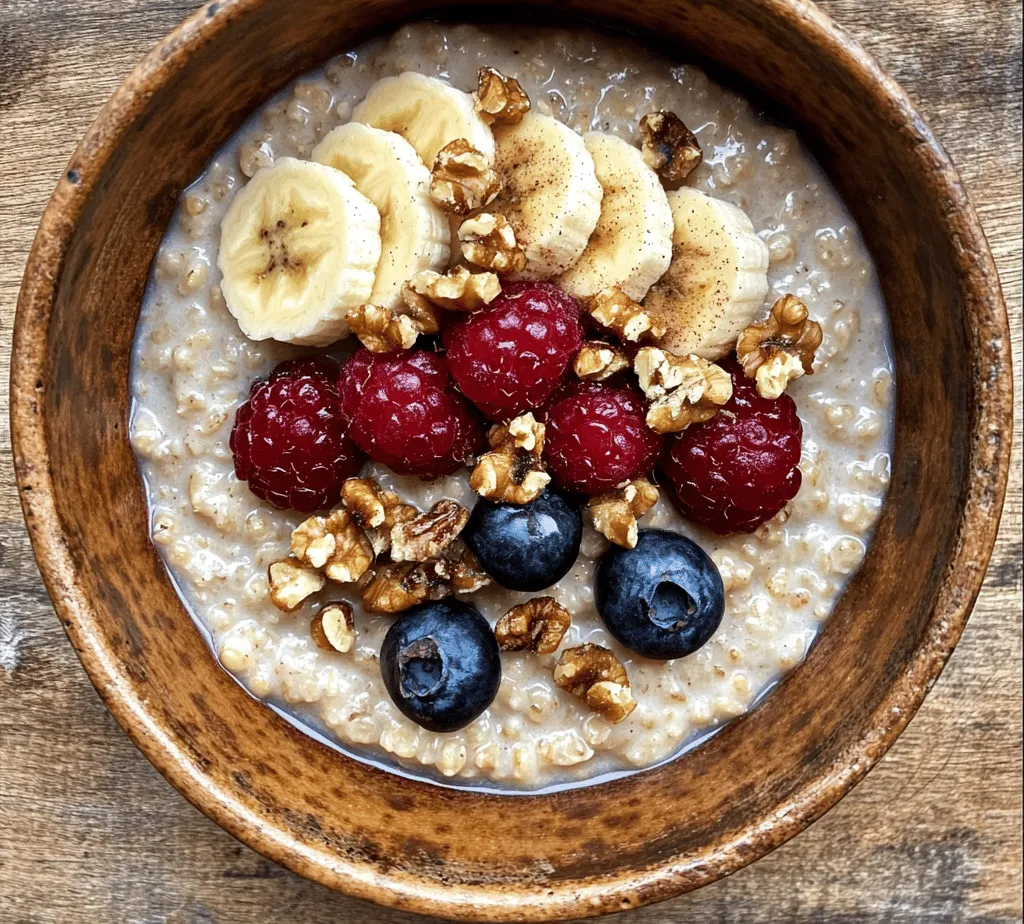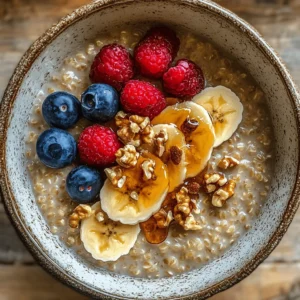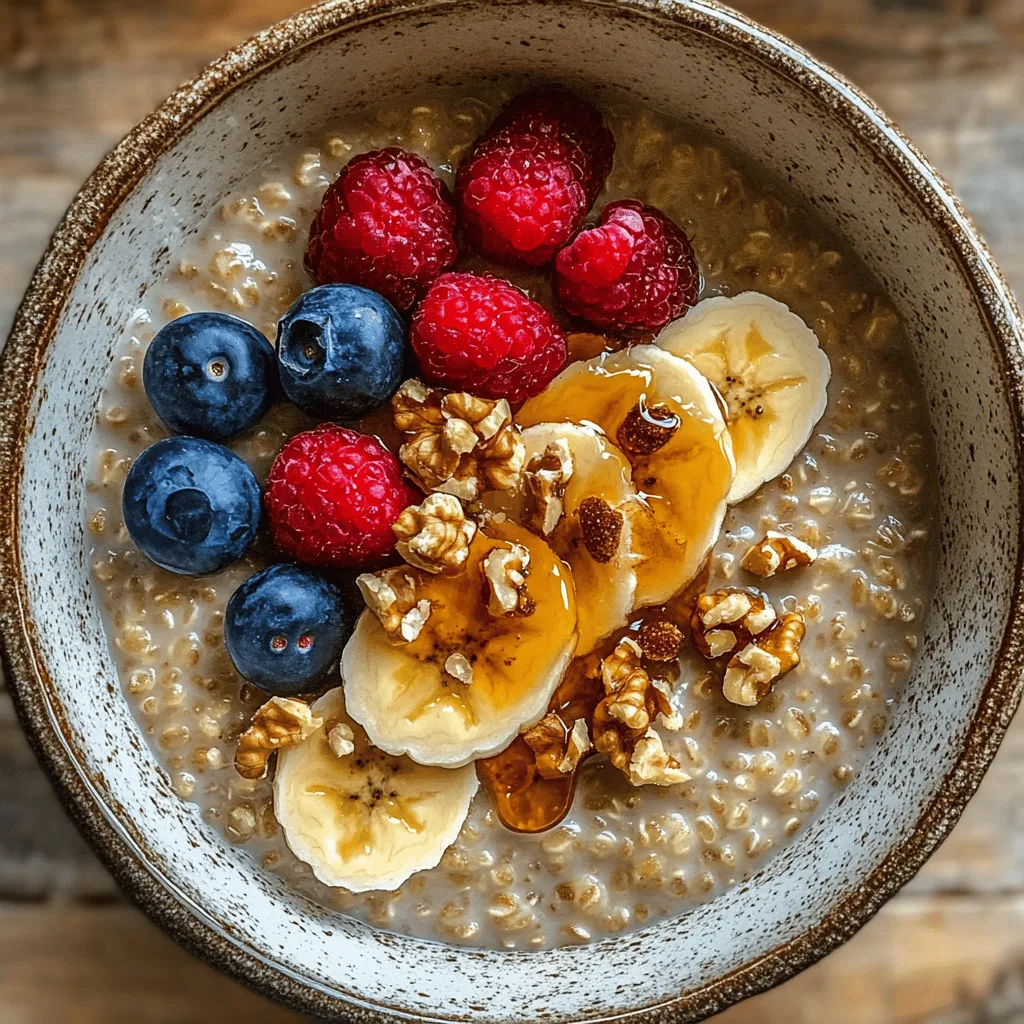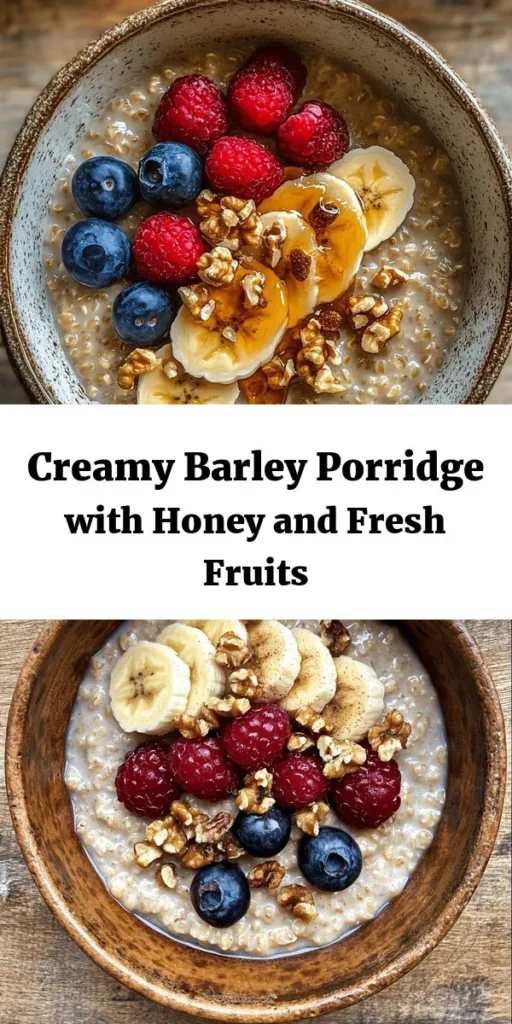Introduction
Barley, a grain that has nourished humanity for millennia, is making its way back into modern kitchens, celebrated for its remarkable nutrition and versatility. This ancient grain is not only a staple in various cultures but has also gained popularity among health enthusiasts looking for wholesome alternatives to conventional breakfast options. Enter warm barley porridge—a comforting, hearty dish that promises to start your day on a nourishing note.
Porridge, in its many forms, has long been revered for its ability to warm both the body and soul. There’s something undeniably soothing about a bowl of hot porridge, its creamy texture wrapping you in a cozy embrace as you savor each spoonful. The beauty of barley porridge lies not only in its comforting qualities but also in its adaptability; you can customize it to suit your taste preferences or dietary needs. Whether you prefer a simple preparation or a more extravagant topping affair, barley porridge is an excellent canvas for your culinary creativity.
In this article, we will explore the nutritional benefits of barley, delve into the reasons why porridge deserves a spot on your breakfast table, and guide you through the process of making warm and wholesome barley porridge from scratch. Prepare to embrace a nourishing start to your day!
Understanding Barley: A Nutritional Powerhouse
Barley is often overshadowed by other grains like oats and quinoa, but it deserves its moment in the spotlight. Specifically, pearl barley, which is the most commonly used form in cooking, is a refined grain with the outer hull removed, making it quick to cook while still retaining many of its nutritional benefits.
What makes barley stand out among other grains is its impressive nutrient profile. First and foremost, barley is a fantastic source of dietary fiber, particularly beta-glucans, which have been shown to lower cholesterol levels and improve heart health. One serving of cooked barley can provide around 6 grams of fiber, exceeding that of oats, which makes it an excellent choice for promoting digestive health.
In addition to fiber, barley is packed with essential vitamins and minerals. It is a good source of B vitamins, such as niacin and thiamine, which are vital for energy metabolism, as well as important minerals like selenium, magnesium, and phosphorus. These nutrients contribute to overall health and well-being, making barley a grain worth including in your diet.
When compared to quinoa, barley holds its own. Although quinoa is often hailed as a superfood, barley provides a unique set of nutrients and has a lower glycemic index, which can be beneficial for maintaining stable blood sugar levels. This means that incorporating barley into your meals can help you stay energized and satiated for longer periods.
Why Choose Porridge for Breakfast?
Breakfast is often touted as the most important meal of the day, and for good reason. A warm, hearty breakfast sets the tone for the day ahead, providing your body with the fuel it needs to tackle whatever lies ahead. Porridge, in particular, has several advantages that make it an excellent breakfast choice.
Firstly, warm porridge is known for its ability to deliver sustained energy. The complex carbohydrates in barley break down slowly, providing a steady release of energy that helps prevent the mid-morning slump. This makes barley porridge an ideal option for those who need to stay focused and productive throughout the day.
Moreover, porridge is a staple in various cultures around the world, each with its own unique twist. From the Scottish oatmeal to the Asian congee, the comforting qualities of porridge are universally appreciated. It serves not only as a nourishing breakfast but also as a base for creative toppings, allowing you to personalize your dish according to your preferences.
The benefits of a warm breakfast extend beyond mere nutrition; it can also promote feelings of comfort and satisfaction. In our fast-paced world, taking the time to enjoy a warm bowl of porridge can serve as a moment of mindfulness, helping to center your thoughts before the day begins.
Ingredients Breakdown
Creating the perfect bowl of warm barley porridge requires a thoughtful selection of ingredients. Here’s a detailed breakdown of each component that contributes to this nourishing breakfast dish:
Pearl Barley
As the star of the show, pearl barley is the primary ingredient in this porridge. Its chewy texture and nutty flavor provide a delightful base. When cooked, pearl barley absorbs water and swells, transforming into a creamy, satisfying porridge. Notably, opting for whole grain barley can elevate the nutritional profile even further, offering additional fiber and nutrients.
Water vs. Milk
When it comes to preparing barley porridge, the choice between water and milk can significantly influence the final texture and flavor. Using water results in a lighter porridge that allows the natural taste of barley to shine through. On the other hand, cooking barley in milk (dairy or plant-based) adds creaminess and richness, making it a more indulgent breakfast option. If you desire a balance, consider using a mix of both!
Salt
While it may seem counterintuitive to add salt to a sweet breakfast dish, a pinch of salt plays a crucial role in enhancing the overall flavor profile of your porridge. Salt brings out the natural sweetness of the barley and any toppings you choose. Just a small amount is needed to elevate the taste without making the porridge overly salty.
Sweeteners (Honey/Maple Syrup)
To sweeten your barley porridge, consider using natural sweeteners like honey or maple syrup. These options not only add sweetness but also bring their unique flavors. Honey lends a floral note, while maple syrup adds a rich, caramel-like sweetness. Both sweeteners offer health benefits compared to refined sugars, making them a preferable choice for those looking to keep their breakfast wholesome.
Vanilla Extract and Cinnamon
To infuse your porridge with warmth and depth, vanilla extract and cinnamon are excellent additions. Vanilla extract enhances the overall flavor, creating a comforting aroma that will entice your senses. Meanwhile, cinnamon adds a hint of spice, which complements the nutty flavor of barley beautifully. Together, they create a harmonious blend that transforms your porridge into a delightful morning treat.
Dried Fruits and Nuts
For added texture and nutritional benefits, consider incorporating dried fruits and nuts into your barley porridge. Dried fruits like raisins, cranberries, or apricots provide natural sweetness and chewiness, while nuts such as almonds or walnuts add crunch and healthy fats. This combination not only enhances the flavor but also increases the satiety of your breakfast, making it more filling.
Fresh Fruits and Yogurt
As a finishing touch, topping your porridge with fresh fruits and a dollop of yogurt can elevate the dish to new heights. Fresh fruits like berries, bananas, or sliced apples provide a burst of freshness and color, while yogurt adds creaminess and a dose of probiotics. This final layer of toppings not only enhances the visual appeal but also brings a delightful contrast in flavors and textures.
Step-by-Step Instructions for Making Barley Porridge
Now that you have a clear understanding of the ingredients and their roles, it’s time to dive into the step-by-step process of making your warm and wholesome barley porridge. Follow these instructions to create a delicious breakfast that will keep you fueled throughout the morning:
1. Rinse the Pearl Barley: Begin by rinsing 1 cup of pearl barley under cold water. This helps to remove any residual dust or impurities, ensuring a clean taste.
2. Combine Barley and Liquid: In a medium saucepan, combine the rinsed barley with 4 cups of water or milk, depending on your preference. If you want a richer texture, using a combination of both can yield excellent results.
3. Add Salt: Stir in a pinch of salt to enhance the flavor of the porridge.
4. Bring to a Boil: Place the saucepan over medium-high heat and bring the mixture to a boil. Once boiling, reduce the heat to low.
5. Simmer: Cover the saucepan and let the barley simmer for about 30-40 minutes. Stir occasionally to prevent sticking and ensure even cooking. The barley should become tender and creamy.
6. Check Consistency: After 30 minutes, check the consistency of the porridge. If you prefer a thicker porridge, continue to simmer until it reaches your desired texture. For a creamier consistency, feel free to add more liquid as needed.
7. Flavor it Up: Once the barley is cooked to your liking, remove the saucepan from heat. Stir in 1 teaspoon of vanilla extract and 1 teaspoon of ground cinnamon for flavor. Mix well to combine all the ingredients.
8. Serve and Top: Ladle the warm barley porridge into bowls and serve it hot. Top with your choice of dried fruits, nuts, fresh fruits, and a dollop of yogurt for a complete, nourishing breakfast experience.
With these steps, you’ll have a delightful bowl of warm barley porridge that is not only satisfying but also packed with nutrients. Whether you enjoy it plain or dressed up with your favorite toppings, this wholesome breakfast is sure to become a cherished part of your morning routine. Stay tuned for more tips and variations to customize your porridge experience!

Clear and Concise Instructions with Detailed Explanations
Rinsing the Barley: Importance of Cleanliness
Before diving into the cooking process, it’s crucial to start with clean barley. Rinsing not only removes dust and impurities but also helps eliminate some of the natural starches, which can create a gummy texture. To rinse the barley, place it in a fine-mesh strainer and run it under cold water for about 1-2 minutes. Gently agitate the barley with your fingers to ensure all grains are well cleaned. This simple step enhances the overall mouthfeel and ensures that your porridge is as wholesome as possible.
Cooking Process: Boiling and Simmering Tips
Once the barley is rinsed, the next step is cooking it. In a large pot, combine 1 cup of rinsed barley with 3 cups of water or plant-based milk for a creamier texture. Add a pinch of salt to enhance the flavor. Bring the mixture to a boil over medium-high heat.
Once boiling, reduce the heat to low, cover the pot, and let it simmer gently. Cooking times may vary depending on the type of barley used: pearl barley typically takes about 30-40 minutes, while hulled barley may take 50-60 minutes. Stir occasionally to prevent sticking and check for doneness; the grains should be tender but still slightly chewy. If the mixture appears too thick, feel free to add more water or milk, a little at a time, until the desired consistency is achieved.
Mixing in Sweeteners and Flavorings: Achieving the Right Balance
Once the barley is cooked to perfection, it’s time to enhance its flavor. Add your choice of sweeteners such as honey, maple syrup, or agave nectar. Start with 1-2 tablespoons and adjust according to your taste preference.
For a flavor boost, consider incorporating spices like cinnamon, nutmeg, or vanilla extract. These ingredients not only enhance the taste but also add warmth and aroma to your porridge. Mix well and let the flavors meld for a few minutes over low heat before serving.
Incorporating Dried Fruits: Timing for Optimal Texture
Dried fruits such as raisins, cranberries, or apricots can add natural sweetness and chewy texture to your barley porridge. Add them during the last 5-10 minutes of cooking to allow them to soften and infuse their flavors into the porridge without losing their texture. If you prefer fresher flavors, consider adding them just before serving.
Serving Suggestions: Plating and Presentation Ideas
To serve your warm barley porridge, ladle a generous portion into a bowl. You can enhance its visual appeal by garnishing with fresh fruits, nuts, seeds, or a drizzle of additional sweetener on top. A sprinkle of chia seeds or a dollop of yogurt can add creaminess and a nutritional boost. For an extra touch, serve it with a side of creamy nut butter or a sprinkle of cocoa powder for a delightful twist.
For an elegant presentation, consider using rustic bowls or plates that highlight the earthy tones of the barley. A few sprigs of mint or a slice of lemon can also elevate the dish visually.
Customizing Your Barley Porridge
Suggestions for Alternative Sweeteners and Flavorings
The beauty of barley porridge lies in its versatility. If you are looking for alternative sweeteners, coconut sugar or date syrup are excellent options that provide a rich flavor profile. For flavorings, try adding almond extract for a nutty essence or cardamom for a hint of exotic spice.
Different Nut and Dried Fruit Combinations
Mixing and matching nuts and dried fruits can create endless flavor combinations. Almonds, walnuts, or pecans can add crunch, while dried figs, dates, or cherries can introduce a different sweetness. Don’t hesitate to experiment with different combinations to find your favorite mix!
Seasonal Variations: Using Fresh Fruits According to Season
Take advantage of seasonal produce to keep your barley porridge exciting. In the spring, top with fresh strawberries or blueberries; in the summer, freshly sliced peaches or apricots are delightful. Fall brings a bounty of apples and pears, while winter can be brightened with citrus fruits or pomegranate seeds.
Vegan and Dairy-Free Options: Substitutions for Milk and Yogurt
For those following a vegan or dairy-free diet, barley porridge can easily accommodate these preferences. Substitute regular milk with almond, oat, or coconut milk for a creamy texture. For yogurt, consider using coconut yogurt or a plant-based alternative, which can offer a similar tangy profile without dairy.
Health Benefits of Barley Porridge
How Barley Porridge Can Aid Digestion and Promote Gut Health
Barley is a whole grain rich in dietary fiber, which plays a crucial role in digestive health. The soluble fiber in barley can help regulate bowel movements and promote the growth of healthy gut bacteria, making it an excellent choice for maintaining digestive health.
The Impact of Whole Grains on Heart Health
Incorporating whole grains like barley into your diet is linked with lower cholesterol levels and reduced risk of heart disease. The beta-glucans in barley help reduce bad cholesterol and support overall heart health, making it a heart-friendly breakfast option.
Potential Benefits for Weight Management and Satiety
Barley porridge is not only filling but also helps maintain satiety due to its high fiber content. Starting your day with a hearty bowl can keep hunger at bay longer, which may help with weight management and prevent unhealthy snacking.
Nutritional Comparisons to Other Breakfast Options
When compared to traditional breakfast options like sugary cereals or white bread, barley porridge shines in its nutritional profile. It offers more fiber, vitamins, and minerals, making it a more wholesome choice for those looking to fuel their day healthily.
Serving and Storage Suggestions
Ideal Serving Size and Portion Ideas
A standard serving size of barley porridge is about 1 cup cooked. This portion provides a balanced start to your day and can be adjusted based on individual dietary needs and activity levels. For those with higher energy requirements, consider increasing the portion size, while those aiming for lighter meals might opt for ½ cup.
How to Store Leftovers and Reheating Instructions
Store any leftover barley porridge in an airtight container in the refrigerator for up to 3-4 days. When ready to enjoy, reheat gently on the stove over low heat, adding a splash of water or milk to restore creaminess. Alternatively, you can reheat it in the microwave, stirring occasionally until warmed through.
Ideas for Enjoying Barley Porridge Beyond Breakfast
Barley porridge can transcend breakfast and be enjoyed as a nutritious snack or dessert. Consider sweetening it with a bit of cocoa powder and serving it as a warm dessert topped with fruit. Alternatively, use leftover porridge as a base for savory bowls with sautéed vegetables or poached eggs for a wholesome lunch or dinner option.
Conclusion
Warm barley porridge is not only a comforting breakfast option but also a powerhouse of nutrition. Its high fiber content, heart health benefits, and versatility make it an excellent choice for anyone looking to enhance their diet. By experimenting with different ingredients and flavors, you can create a personalized bowl that suits your taste and dietary needs.
Integrating barley porridge into your daily routine can lead to improved health and wellness, making it a worthwhile addition to your breakfast lineup. So, gather your ingredients, follow these steps, and enjoy the wholesome goodness that barley porridge has to offer!



